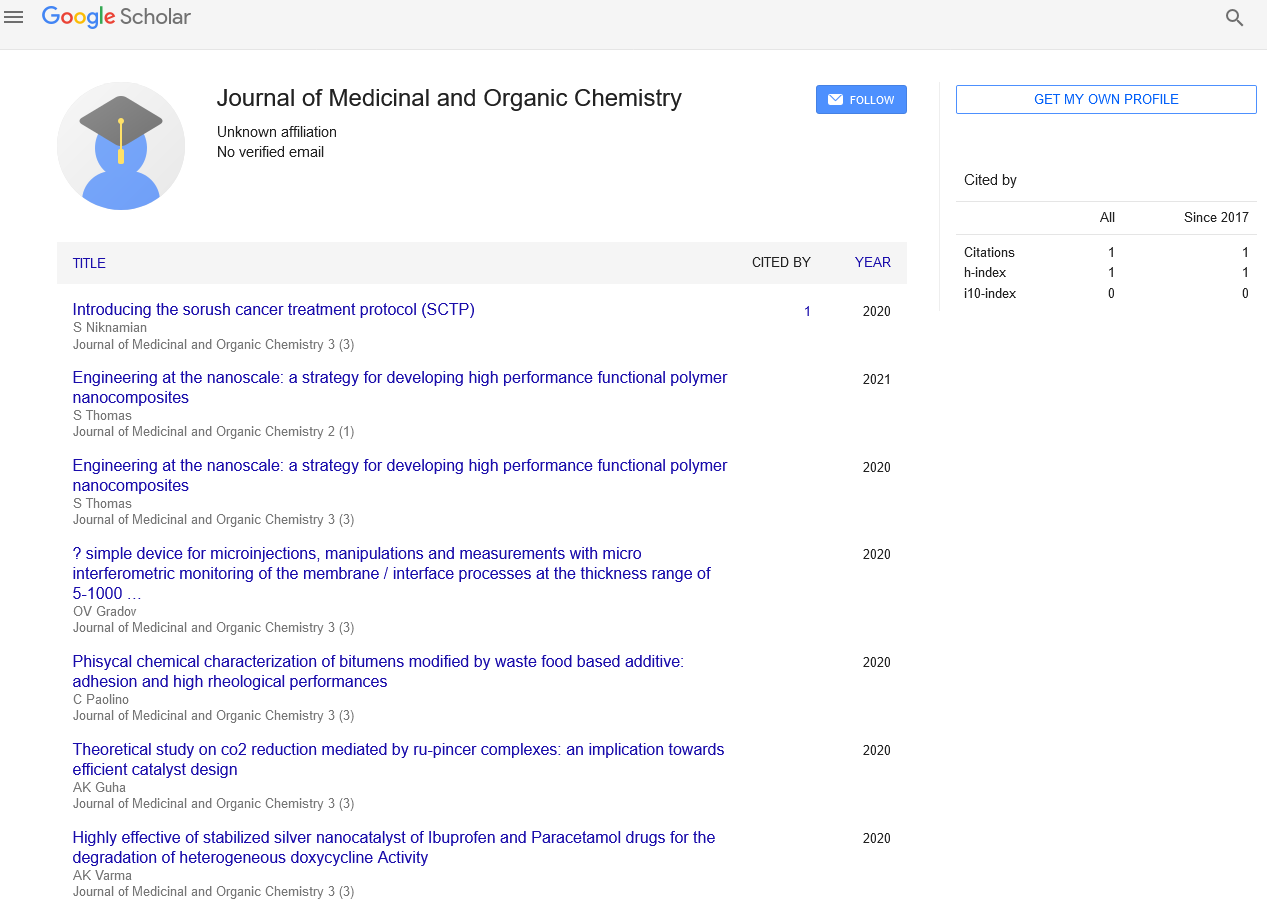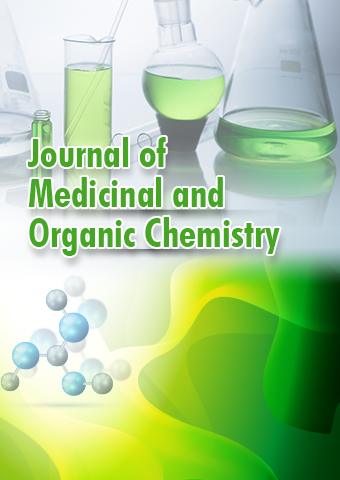Editorial - Journal of Medicinal and Organic Chemistry (2023) Volume 6, Issue 3
Exploring the Evolving Landscape of Medicinal Chemistry: Advancements, Applications, and Future Perspectives
Dr. Sakshi Tomar*
Department of Medicinal Chemistry, Indian Institute of Technology, India
Department of Medicinal Chemistry, Indian Institute of Technology, India
E-mail: sakshit.@gmail.com
Received: 02-June-2023, Manuscript No. jmoc-23-101941; Editor assigned: 05-June-2023, PreQC No. jmoc-23- 101941; Reviewed: 19-June-2023, QC No. jmoc-23-101941; Revised: 22- June-2023, Manuscript No. jmoc-23- 101941 (R); Published: 29-June-2023; DOI: 10.37532/jmoc.2023.6(3).54-57
Abstract
Medicinal chemistry is an interdisciplinary field at the forefront of drug discovery and development, combining the principles of chemistry, biology, pharmacology, and computational sciences to design and synthesize novel therapeutic agents. This abstract provides an overview of the field of medicinal chemistry, highlighting its significance in addressing unmet medical needs, advances in drug design and synthesis, and the exploration of emerging technologies shaping the future of this field. The primary objective of medicinal chemistry is to identify, optimize, and develop small molecules that selectively interact with specific biological targets to modulate their activity, thereby providing effective treatments for various diseases. The process typically begins with target identification and validation, followed by hit identification, lead optimization, and preclinical and clinical evaluations. The integration of medicinal chemistry with computational techniques, such as molecular modeling, virtual screening, and quantitative structure-activity relationship (QSAR) analysis, has revolutionized the drug discovery process by enabling the rational design of novel compounds with enhanced pharmacological properties. Over the years, significant advancements in medicinal chemistry have been made, driven by advances in chemical synthesis methodologies, high-throughput screening technologies, and the advent of computational tools. These developments have allowed researchers to explore a broader chemical space, leading to the discovery of highly potent and selective drug candidates. Additionally, the field has witnessed a shift towards more target-specific and personalized medicine approaches, including the design of targeted therapeutics, antibody-drug conjugates, and prodrugs. Furthermore, the emergence of innovative technologies has significantly impacted medicinal chemistry. The application of structural biology techniques, such as X-ray crystallography, cryo-electron microscopy, and nuclear magnetic resonance spectroscopy, has provided detailed insights into the three-dimensional structures of drug targets, facilitating structure-based drug design. Moreover, the integration of artificial intelligence (AI) and machine learning algorithms has enabled the analysis of vast amounts of data, prediction of drug-target interactions, and acceleration of lead optimization processes.
Keywords
Medicinal chemistry • Drug discovery • Chemistry • Biology • Pharmacology • X-ray crystallography • Cryo-electron microscopy
Introduction
Medicinal chemistry is a multidisciplinary field that combines the principles of chemistry, biology, and pharmacology to design and develop drugs for the treatment of various diseases [1]. It plays a crucial role in the discovery, development, and optimization of new therapeutic agents that can improve human health and quality of life. Medicinal chemists employ a wide range of scientific techniques and approaches to identify, synthesize, and evaluate potential drug candidates, with the ultimate goal of translating scientific discoveries into effective medications. The process of medicinal chemistry begins with target identification, where researchers identify specific biological targets that are involved in a particular disease [2]. These targets can be enzymes, receptors, ion channels, or other biomolecules that play a role in the disease pathology. Once a target is identified, medicinal chemists begin the process of designing and synthesizing small molecules that can interact with the target and modulate its activity.
The design of a drug molecule involves considering several factors, such as its chemical structure, physicochemical properties, and the desired pharmacological profile. Medicinal chemists use computational tools and modelling techniques to predict the behavior of drug candidates in the body, which helps in selecting the most promising molecules for further development [3]. They also take into account factors like bioavailability, toxicity, and metabolic stability to ensure that the drug molecule is safe and effective. Synthesis is a crucial step in medicinal chemistry, as it involves the preparation of the desired drug molecules in the laboratory. Medicinal chemists employ various synthetic strategies and techniques to assemble complex organic molecules. They utilize their knowledge of chemical reactions and reactivity to design efficient synthetic routes that can be scaled up for mass production. After synthesizing the drug candidates, medicinal chemists evaluate their biological activity and select the most potent and selective compounds for further optimization [4]. This process involves modifying the chemical structure of the lead compounds to improve their pharmacokinetic properties, enhance their efficacy, and minimize any adverse effects. Medicinal chemists perform structure-activity relationship (SAR) studies to understand the relationship between the chemical structure of a molecule and its biological activity [5]. This knowledge guides the design of subsequent generations of compounds with improved drug-like properties. In addition to SAR studies, medicinal chemists also utilize various techniques to optimize the drug candidates. These include molecular modeling, where computational methods are used to predict how modifications to the chemical structure will affect the binding affinity and selectivity of the molecule. Medicinal chemists also employ combinatorial chemistry, high-throughput screening, and other innovative approaches to efficiently explore chemical space and identify new lead compounds [6].
The final step in medicinal chemistry is the preclinical evaluation of the optimized drug candidates. This involves a series of in vitro and in vivo experiments to assess the pharmacological activity, toxicity, and pharmacokinetic properties of the molecules [7]. Medicinal chemists work closely with biologists, pharmacologists, and other experts to interpret the results and select the most promising candidates for further development.
Once a drug candidate successfully completes preclinical testing, it enters the clinical trial phase, where its safety and efficacy are evaluated in human subjects. Medicinal chemists play a vital role in supporting the clinical development process by providing chemical expertise, analysing drug metabolism and pharmacokinetics data, and assisting in the design of clinical trials [8]. The field of medicinal chemistry has made significant contributions to healthcare by discovering and developing numerous lifesaving drugs. Examples of drugs developed through medicinal chemistry include antibiotics, antiviral agents, anticancer drugs, cardiovascular medications, and treatments for neurological disorders. Advances in medicinal chemistry have led to improved therapeutic options, increased efficacy, and reduced side effects for many diseases [9]. Furthermore, medicinal chemistry continues to evolve with advancements in technology and scientific understanding. Researchers are exploring new areas such as targeted drug delivery systems, nanomedicine, and personalized medicine to develop more precise and effective therapies [10].
Conclusion
Medicinal chemistry plays a pivotal role in the discovery and development of new therapeutic agents. The field continues to witness rapid progress due to advancements in synthetic chemistry, computational methods, and technological innovations. By leveraging these developments, medicinal chemists strive to overcome challenges associated with disease treatment, develop safer and more effective drugs, and ultimately improve human health. The interdisciplinary nature of medicinal chemistry offers a promising platform for collaboration among scientists from various disciplines, fostering innovation and the translation of scientific discoveries into impactful clinical interventions.
References
- Kant AK. Dietary patterns and health outcomes. J Am Diet Assoc.104,615-635 (2004).
- Esfahani A, Wong J MW, Truan J et al. Health effects of mixed fruit and vegetable concentrates: a systematic review of the clinical interventions. J Am Coll Nutr.30,285-294(2011).
- Heidemann C, Scheidt-Nave C, Richter A et al. Dietary patterns are associated with cardiometabolic risk factors in a representative study population of German adults. British Journal of Nutrition. 106,1253-1262 (2011).
- Smilek DE, Ehlers MR, Nepom GT. Restoring the balance: immunotherapeutic combinations for autoimmune disease. Disease Models & Mechanisms. 7, 503-513 (2014).
- Singh RP, Waldron RT, Hahn BH. Genes, tolerance and systemic autoimmunity. Autoimmunity Reviews. 11, 664-669 (2012).
- Böhm I. Disruption of the cytoskeleton after apoptosis induction with autoantibodies. Autoimmunity. 36, 183-189 (2003).
- Slavkin, Harold C. Evolution of the scientific basis for dentistry and its impact on dental education, past, present, and future. Journal of Dental Education. 76, 28-35(2012).
- Leggat PA. Occupational hygiene practices of dentists in southern Thailand. International Dental Journal. 51, 11-16(2001).
- Angum, Fariha, Khan. The Prevalence of Autoimmune Disorders in Women, A Narrative Review. Cureus. 12, 80-94 (2020).
- Cotsapas C, Hafler DA. Immune-mediated disease genetics, the shared basis of pathogenesis. Trends in Immunology. 34, 22-26 (2013).
Indexed at, Google Scholar, Crossref
Indexed at, Google Scholar, Crossref
Indexed at, Google Scholar, Crossref
Indexed at, Google Scholar, Crossref
Indexed at, Google Scholar, Crossref
Indexed at, Google Scholar, Crossref
Indexed at, Google Scholar, Crossref
Indexed at, Google Scholar, Crossref
Indexed at Google Scholar, Crossref

